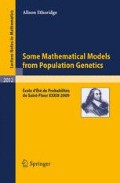Abstract
The main purpose of theoretical population genetics is to understand the complex patterns of genetic variation that we observe in the world around us. Its origins can be traced to the pioneering work of Fisher, Haldane and Wright. Their contributions were fundamental in establishing the Modern Evolutionary Synthesis, in which Darwin’s theory of evolution by natural selection was finally reconciled with Mendelian genetics. Darwin’s theory of evolution Darwin (1859) can be simply stated: “Heritable traits that increase reproductive success will become more common in a population”. Thus, in order for natural selection to act, there must be variation within a population and offspring must be similar to their parents. So to fully understand evolution we need a mechanism whereby variation is created and inherited. This is provided by Mendelian genetics Mendel (1866). Again the idea can be simply stated. Traits are determined by genes. Each gene occurs in finitely many different types that we call alleles and different alleles may produce different traits. Offspring are similar to their parents because they inherit genes from their parents. The difficulty is that Darwin had argued that evolution of complex, welladapted organisms depends on selection acting on a large number of slight variants in a trait and much ofMendel’s work deliberately focused on discontinuous changes in traits determined by a single gene.
Access this chapter
Tax calculation will be finalised at checkout
Purchases are for personal use only
Author information
Authors and Affiliations
Corresponding author
Rights and permissions
Copyright information
© 2011 Springer-Verlag Berlin Heidelberg
About this chapter
Cite this chapter
Etheridge, A. (2011). Introduction. In: Some Mathematical Models from Population Genetics. Lecture Notes in Mathematics(), vol 2012. Springer, Berlin, Heidelberg. https://doi.org/10.1007/978-3-642-16632-7_1
Download citation
DOI: https://doi.org/10.1007/978-3-642-16632-7_1
Published:
Publisher Name: Springer, Berlin, Heidelberg
Print ISBN: 978-3-642-16631-0
Online ISBN: 978-3-642-16632-7
eBook Packages: Mathematics and StatisticsMathematics and Statistics (R0)

